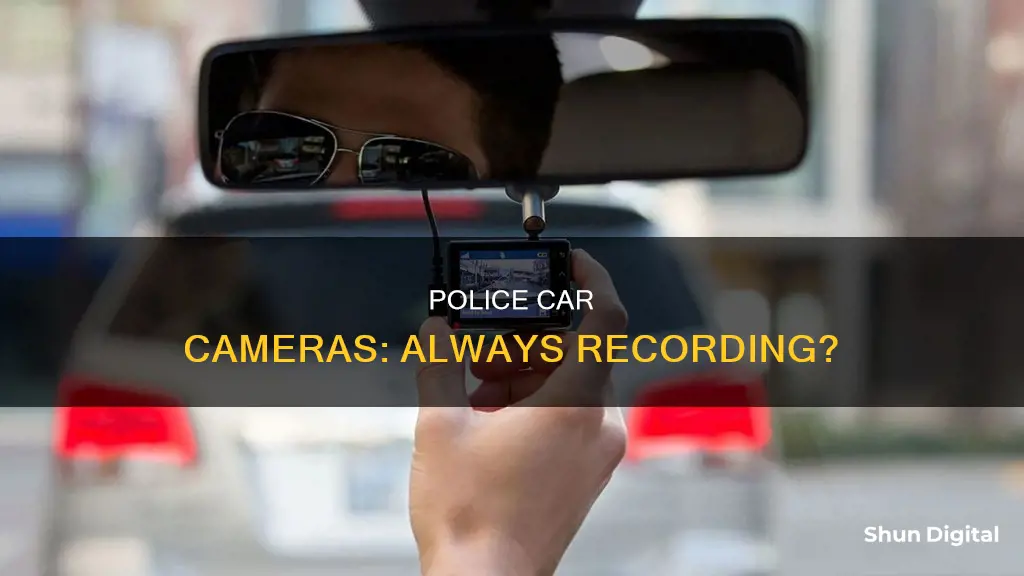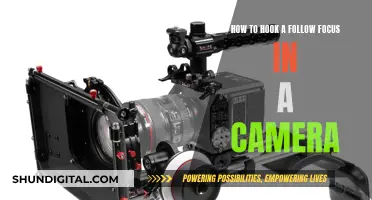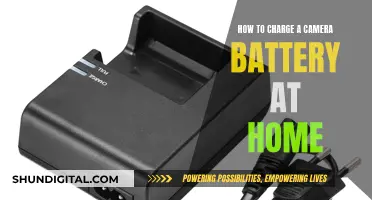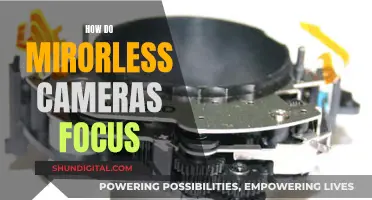
Police car cameras are often integrated into a car's electrical system, allowing them to be activated by triggers such as emergency lights and sirens. In some cases, cameras are set to turn on automatically when the car is started, ensuring that every incident is recorded. The use of police car cameras has become increasingly common, with nearly 72% of state patrol vehicles now utilizing this technology. These cameras provide an objective account of incidents, aiding in evidence collection and improving police accountability. While most cameras require manual activation, certain models with advanced features, such as panoramic views and high-definition video, offer continuous recording capabilities.
| Characteristics | Values |
|---|---|
| Are cop car cameras always on? | It depends on the policy of the city/district, as well as the personal discretion of the cop in charge. |
| Do all police cars have video cameras installed? | Most police cars have video cameras installed on them, especially in the US. |
| When do police car cameras start recording? | Some cameras turn on automatically once the car starts. Others are triggered by the officer turning on the lights and/or siren, or by the car's speed or movement. |
| How long do police car cameras record for? | Some cameras can record up to 40 hours of video. |
| What do police car cameras record? | Police car cameras typically record video and audio of activity surrounding the vehicle, including in front of and behind the car, and inside the car to monitor prisoners. |
| How is the footage used? | Footage is used as evidence in court, to increase accountability by monitoring officer activity, and to help with investigations. |
What You'll Learn
- Police car cameras are often triggered by turning on emergency lights and sirens
- Some cameras are set to turn on when the car is started
- Cameras can be manually activated by an officer
- Cameras provide an objective account of incidents, protecting both officers and citizens
- Recordings are used as evidence in court and to increase accountability

Police car cameras are often triggered by turning on emergency lights and sirens
The use of police car cameras has become increasingly common in law enforcement over the last 20 years. Advancements in technology have led to the development of police car cameras, body cameras, and high-tech squad cars, all of which contribute to the safety of both officers and citizens. These devices provide an objective account of incidents, helping to protect officers legally and ensuring accountability for their actions.
Police car cameras are typically hardwired into the vehicle's electrical systems, allowing them to be activated by specific triggers. One of the most common triggers for these cameras is the activation of emergency lights and sirens. When an officer turns on their emergency lights and siren, the camera system automatically starts recording, capturing the situation unfolding in front of the police car. This feature ensures that critical events are recorded without the need for manual activation, providing a valuable tool for evidence collection and incident review.
However, it is important to note that not all dash cameras are triggered in the same way. In some cases, officers may still need to manually activate the camera system. Additionally, the camera systems may have different settings, allowing for the activation of specific cameras based on the situation. For instance, in the Palo Alto Police Department, the system includes five cameras that provide a comprehensive view of the vehicle's surroundings and the interior.
The automatic recording feature of police car cameras offers several benefits. Firstly, it ensures that every incident, inside and outside the car, is recorded, providing a detailed account of events. Secondly, it helps protect officers against frivolous complaints and holds them accountable for their actions, promoting transparency and trust between law enforcement and the public. Lastly, the footage captured by these cameras can be used as evidence in court, aiding in the pursuit of justice.
In conclusion, police car cameras play a crucial role in modern law enforcement, and their activation through emergency lights and sirens is a significant step forward in ensuring the safety and accountability of officers, as well as providing valuable evidence for legal proceedings.
Unlocking Camera Raw: The Power of Presets
You may want to see also

Some cameras are set to turn on when the car is started
The use of police car cameras has become increasingly common in the last 20 years, with 72% of state patrol vehicles now utilizing this technology. The cameras are hardwired into the vehicle's electrical systems, allowing them to be activated by programmed triggers. While some cameras are manually activated by officers, others are set to turn on automatically when the car is started, ensuring that every incident is recorded regardless of whether the officer remembers to activate the camera. This is particularly important for capturing crucial events and incidents that occur on roads and highways.
In the city of Palo Alto, for example, the police department's cars are equipped with a multiple-camera video system that automatically starts recording video from all five cameras as soon as the car is turned on. This system provides a 270-degree view around the vehicle and clear audio, which can be useful for monitoring officer activity and providing an independent, objective record of encounters. The recordings can be used as evidence in court and to increase accountability.
The automatic activation of police car cameras when the vehicle is started varies depending on the jurisdiction and the specific camera system in use. In Lancaster, PA, for instance, the State Police use a system that turns on and begins recording 30 seconds before the overhead lights are activated. In some cases, the cameras may only start recording when the lights and sirens are turned on, or there may be a mix of camera systems within a single department depending on the age of the vehicles.
The extensive video and audio data generated by these camera systems can be challenging to store and manage, requiring significant server capacity and infrastructure. Additionally, policies must be in place to govern the usage and retention of the data, which is typically kept for a set period, such as 30 days, unless it is needed as evidence in a criminal case.
Converting Camera Raw Files: Bulk JPEG Conversion Tips
You may want to see also

Cameras can be manually activated by an officer
In some cases, police car cameras can be manually activated by an officer. While the specifics may vary across different police departments and jurisdictions, there are generally a few common ways in which these cameras can be manually turned on.
One way is through the use of triggers or pre-set conditions. For example, a police car camera may be programmed to automatically start recording when an officer turns on the emergency lights and siren. This allows the camera to capture the situation as it unfolds. However, not all dash cameras have this capability, and sometimes an officer may need to manually activate the camera themselves.
The officer may have a dedicated button or switch to turn on the camera, especially in cases where the camera system is not automatically triggered by specific events. This ensures that the officer has the agency to capture crucial incidents or events that may occur during their shift.
In addition to manual activation, some police car camera systems are designed to constantly run and record. These cameras may be integrated into the vehicle's electrical system, providing constant updates and evidence collection. This way, even if an officer forgets to manually activate the camera, important incidents inside and outside the car are still recorded.
The presence of these cameras has significantly impacted police work, providing an objective and independent record of events. This not only helps protect officers but also ensures the safety of citizens. The footage captured by these cameras can be used as evidence in court, increasing transparency and accountability in law enforcement.
While the manual activation of police car cameras by officers is an important feature, it is just one aspect of the broader effort to incorporate technology into law enforcement. With advancements in technology, we can expect to see further developments and improvements in police car camera systems, enhancing their capabilities and benefiting both the police and the communities they serve.
Recharging Camera Batteries: Efficient Nightly Routine
You may want to see also

Cameras provide an objective account of incidents, protecting both officers and citizens
In the last 20 years or so, the world of law enforcement has evolved significantly. As technology has become more ingrained in society, law enforcement officers have had to adapt and integrate new devices into their work, such as police car cameras, body cameras, and high-tech squad cars. These advancements aim to enhance the safety of both officers and citizens alike.
Police car cameras, also known as dashboard cameras, play a crucial role in providing an objective account of incidents. By being hardwired into the vehicle's electrical systems, these cameras can be automatically triggered to record based on specific events, such as the activation of emergency lights and sirens. This ensures that every incident, inside and outside the car, is captured on video, providing an unbiased perspective.
The value of dashboard camera footage lies in its ability to offer an independent record of events. This is particularly important when reviewing an officer's actions during a particular incident. The footage serves as digital evidence, protecting officers from frivolous complaints and providing transparency in their interactions with citizens. It also safeguards citizens against any potential impropriety by law enforcement officials.
Additionally, the integration of police car cameras has far-reaching benefits. The cameras provide automatic digital evidence collection, aiding officers in their investigations and court proceedings. They can also assist in monitoring officer activity, increasing accountability and ensuring that any complaints or concerns are addressed appropriately. This two-way protection is essential in fostering trust between law enforcement and the communities they serve.
The implementation of police car cameras has brought about a significant shift in the way police work is conducted. By providing an objective account of incidents, these cameras not only protect officers and citizens but also contribute to the overall improvement of law enforcement practices in the 21st century.
Surveillance Cameras: Are Companies Watching You in Real Time?
You may want to see also

Recordings are used as evidence in court and to increase accountability
The recordings from police car cameras are used as evidence in court and to increase accountability. In the last two decades, there has been a surge in technologies like police car cameras, police body cameras, and high-tech squad cars, which aim to keep both officers and citizens safe. The recordings from these cameras provide an independent, objective record of what the officer encounters. They are also used to increase accountability by monitoring officer activity.
The recordings can protect officers against frivolous complaints and protect the public against impropriety from an officer. For example, in the case of a burglary, police were able to determine that a patrol car had passed by the business in the early morning hours, and video from a side-view camera showed a suspect vehicle in the parking lot, which helped with the investigation.
The cameras in most police cars are turned on while driving and can capture crucial events and incidents. They often record everything in front of the car and, to some extent, behind it. Some models turn the cameras on automatically once the car starts, and some are even set to start recording as soon as the car is turned on. This ensures that every incident inside and outside the car is recorded, regardless of whether someone remembers to activate the camera or not.
The recordings from these cameras provide automatic digital evidence collection, better protecting officers both in the streets and in the courts. They help to establish an offense and identify offenders by recording events in real-time. For example, if a driver allegedly runs a stop sign, an active police cam could help establish the offense without any controversy.
Is Your Camera Battery Charged? Check This Way
You may want to see also
Frequently asked questions
It depends on the policy of the city/district, as well as the personal discretion of the cop in charge. In many jurisdictions, the police dash cams start recording once the car starts. Some dash cams are also triggered when the officer turns on the lights or siren.
Dash cams provide an objective account of what happened during a particular incident, protecting both citizens and officers. They also help in evidence collection and can be used to increase accountability by monitoring officer activity.
The use of dash cams in cop cars can vary depending on the department, the age of the car, and the availability of resources. Some departments may have older systems that require manual activation, while others have newer systems with advanced features. Additionally, the amount of digital storage available can impact whether dash cams can record continuously.
One challenge is the large amount of data storage required to maintain continuous recording. Additionally, dash cams may malfunction or produce blurry or corrupt footage, which can lead to more questions than answers. Departments typically retain footage for a limited period, often no longer than 30 days.







